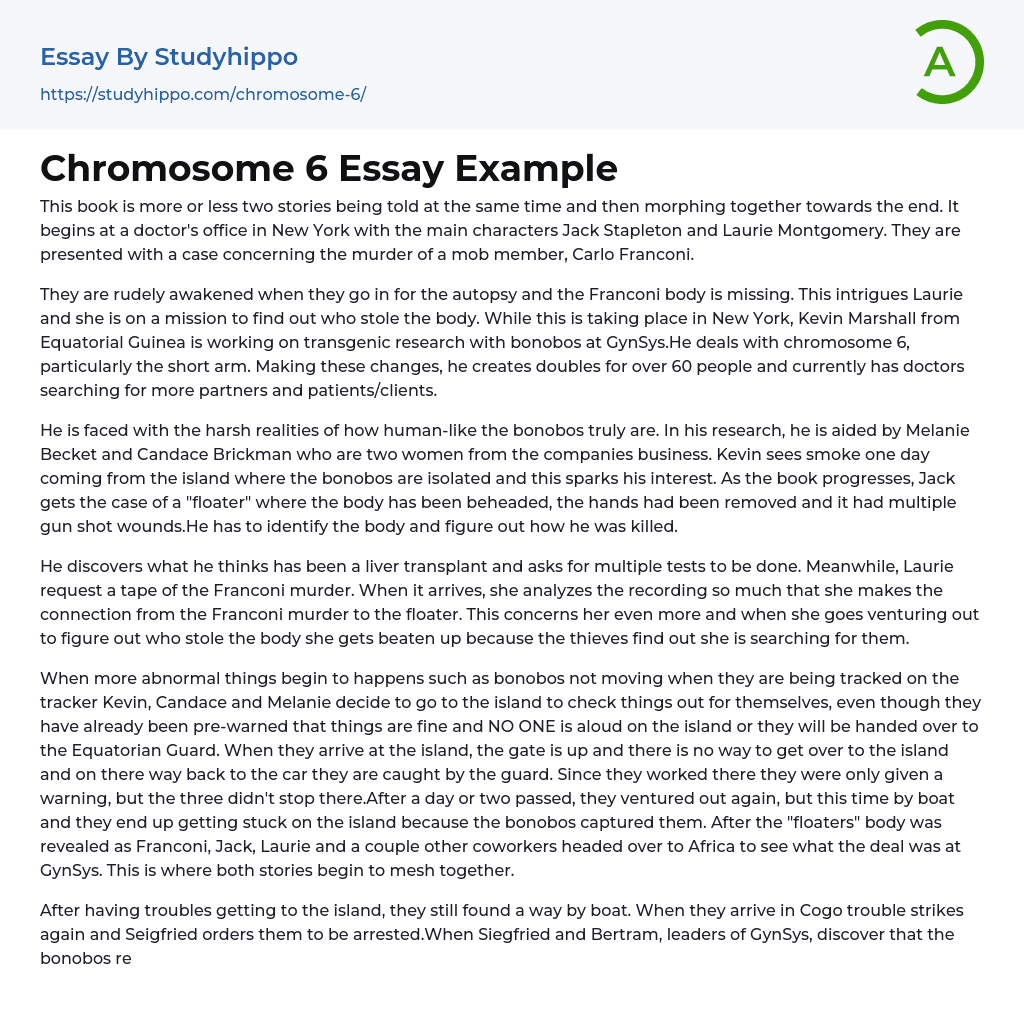The book starts with Jack Stapleton and Laurie Montgomery in a doctor's office in New York. It tells two stories that eventually merge towards the end. The main characters are presented with a case concerning the murder of Carlo Franconi, a member of the mob.
While Laurie investigates the missing Franconi body during an autopsy, Kevin Marshall is conducting transgenic research with bonobos at GynSys. His focus is on chromosome 6's short arm, which enables him to genetically replicate over 60 individuals. Now, he is searching for additional partners and patients/clients with the help of doctors.
Throughout his research, Kevin is confronted with the undeniable similarities between the behavior of bonobos and humans. Assisting him in his work are two women from the company's business, Melanie Becket and Candace Brickman. One day, Kevin notices smoke em
...anating from the isolated island on which the bonobos reside, which piques his interest. As the book progresses, Jack becomes involved in a case involving a "floater" - a body that has been decapitated, dismembered, and shot multiple times. His task is to determine the identity of the deceased and uncover the circumstances surrounding their brutal murder.
While requesting multiple tests for what he believes to be a liver transplant, he also discovers that Laurie has received a tape of the Franconi murder. In analyzing the recording, Laurie connects the Franconi murder to the floater, increasing her concern. Determined to find out who stole the body, she ventures out but is beaten up by the thieves upon being discovered of her search.
As soon as bonobos on Kevin's tracking device stopped moving, Kevin, Candace, and Melanie decided to visit the island an
investigate the unusual events, disregarding the warning not to set foot on the island because it was prohibited by Equatorian Guard. Upon reaching the island, they found a closed gate and no means of access. On their way back to the car, they were apprehended by a Guard. Due to their past employment, they received a warning. Nevertheless, mere days later they returned, this time by boat, and were trapped by the bonobos on the island. Meanwhile, Franconi's dead body led Jack, Laurie, and some coworkers to Africa in order to investigate GynSys. These events cause the two stories to intertwine.
Despite facing difficulties in reaching the island, they managed to find a way by boat. Upon reaching Cogo, they encounter trouble and are ordered to be arrested by Seigfried. Leaders of GynSys, Siegfried and Bertram, discover the extraordinary human-like characteristics of the bonobos (killing, tool-making, spoken language) and decide to capture them. During the mission of capturing bonobos, they discover three workers held hostage in a cave. Instead of being sent to jail, the workers are put on house arrest in Kevin's home with guards providing security. Meanwhile, the four people from New York are imprisoned with guards stationed at the jail. Kevin's housekeeper informs him about their presence and he devises a plan to break them out. All exits are guarded, but then they remember the boat.
Upon leaving Cogo, Kevin convinces the group to free the captive bonobos. However, the plan is foiled by a guard who arrives just as they release the animals, destroying their boat in the process. To escape the island, they retrace Kevin, Candace and Melanie's steps by exploring the
island, finding the boats and escaping back to New York. Upon their return, Laurie is surprised that Vinnie agreed to testify and resolved all of the cases. Although being an organ donor is common, having one's genes in an animal is unexpected. The genetic research in the book is not cruel to animals unnecessarily. It was not Kevin's fault that the bonobos turned out so similar to humans.
Eliminating the bonobos differs from extinguishing a human being because they are merely a replication of humans. If a human-like animal could rescue an actual human’s life, it cannot be considered immoral. In the future, this could have a significant impact on organ transplants. Individuals requiring transplants would no longer face interminable waitlists or suffer from fatal organ failure. Instead, they could receive a clone with the precise match for any organ in their body to sustain them. This research has the potential to save numerous lives.
In the medical field, if a transplant were needed, taking an organ from an animal and causing its death would be less emotionally burdensome to me than having my mother sacrifice her life by donating her organ to save mine. While some animal lovers may object to killing animals, when it is a matter of saving a life, it becomes absolutely necessary and acceptable.
- Anatomy and Physiology essays
- Addiction essays
- Biodegradation essays
- Dental Care essays
- Disease essays
- Disorders essays
- Health Care essays
- Intelligence Quotient essays
- Nutrition essays
- Olfaction essays
- Public Health essays
- Women's Health essays
- World health organization essays
- Cancer essays
- Infectious Disease essays
- Lung Cancer essays
- Neurology essays
- Physical Exercise essays
- Medicine essays
- Sex essays
- Inquiry essays
- Disability essays
- Poison essays
- Action Potential essays
- Nervous System essays
- Childbirth essays
- Puberty essays
- Blood essays
- Kidney essays
- Neuron essays
- Body essays
- Glucose essays
- Sense essays
- Heart essays
- Skeleton essays
- Human Physiology essays
- Eye essays
- Immune System essays
- Muscle essays
- Skin essays
- Brain essays
- Central Nervous System essays
- Human Skin Color essays
- Digestive System essays
- Common sense essays
- Respiration essays
- alcoholism essays
- Smoking essays
- Casino essays
- Tobacco essays




